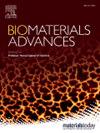Controlled release of amitriptyline via the transdermal route using SmartReservoirs and hydrogel-forming microneedles
IF 5.5
2区 医学
Q2 MATERIALS SCIENCE, BIOMATERIALS
Materials Science & Engineering C-Materials for Biological Applications
Pub Date : 2025-05-27
DOI:10.1016/j.bioadv.2025.214361
引用次数: 0
Abstract
SmartReservoirs (SRs) are novel drug reservoirs made from a cellulose-based matrix for hydrogel-forming microneedles (HF-MNs). SRs can incorporate drug molecules within a cellulose-based matrix in amorphous form. This significantly improves the solubility of poorly soluble drugs, which enhances drug delivery by allowing for rapid dissolution and absorption once the dosage form is administered. In contrast to improving the solubility of hydrophobic drugs, SRs might be used to modify the amorphous/crystalline properties of hydrophilic drugs, thus leading to a controlled release profile. Hence, SRs hold a promise as drug reservoirs for hydrophilic drugs and has not yet been investigated for such drugs; this study explores the transdermal delivery of the hydrophilic model drug amitriptyline hydrochloride (AMT) using SRs. Furthermore, the effect of the cellulose-based matrix on drug loading and release profile was also tested using tissue paper-based (SR-T) and copier paper-based (SR-P) SmartReservoirs. The current research involves the fabrication of HF-MNs and two types of AMT-SRs. Subsequently, a comprehensive characterisation of the HF-MNs and SRs was conducted regarding their morphological features, mechanical and physicochemical properties, amorphous/crystallinity state, interaction with the cellulose matrix, drug distribution, drug loading capacity, and transdermal permeation efficiency. The findings of the study demonstrated that the active pharmaceutical ingredient (API) remained intact within the cellulose matrices of both SRs. The type of cellulose matrix employed had a major influence on the loading and release of the drug. The SR-P demonstrated a significantly enhanced drug loading and release profile compared to the SR-T. The drug content analysis of the SRs revealed that SR-T had approximately 4 mg/cm2 of AMT, in comparison to SR-P, which had a concentration nearly double that amount. The results of the skin deposition and permeation studies were also consistent, indicating that SR-T combined with HF-MNs deposited approximately 75 μg and permeated <150 μg (~5 % delivered), while SR-P combined with HF-MNs deposited approximately 128 μg and permeated >500 μg of AMT into the skin (~9 % delivered). Ultimately, this work provides substantial evidence to support the use of SRs as a hydrophilic drug reservoir for HF-MNs.
使用SmartReservoirs和水凝胶形成微针通过透皮途径控制阿米替林的释放
SmartReservoirs (SRs)是一种新型药物储存库,由纤维素基基质制成,用于形成水凝胶的微针(HF-MNs)。SRs可以将药物分子以无定形的形式结合在纤维素基基质中。这大大提高了难溶性药物的溶解度,一旦给药,通过允许快速溶解和吸收来增强药物传递。与改善疏水药物的溶解度相反,SRs可用于修饰亲水药物的非晶/结晶性质,从而导致控释。因此,SRs有望成为亲水药物的药物储存库,但尚未对此类药物进行研究;本研究探讨了亲水模型药物盐酸阿米替林(AMT)的经皮递送。此外,我们还利用薄纸(SR-T)和复印纸(SR-P) SmartReservoirs测试了纤维素基基质对药物装载和释放的影响。目前的研究包括HF-MNs和两种类型的amt - sr的制备。随后,对HF-MNs和SRs的形态特征、机械和物理化学性质、无定形/结晶状态、与纤维素基质的相互作用、药物分布、药物负载能力和透皮渗透效率进行了全面表征。研究结果表明,活性药物成分(API)在两种SRs的纤维素基质中保持完整。所采用的纤维素基质的类型对药物的装载和释放有主要影响。与SR-T相比,SR-P表现出显著增强的药物装载和释放特征。药物含量分析显示,SR-T的AMT含量约为4 mg/cm2,而SR-P的AMT含量几乎是SR-P的两倍。皮肤沉积和渗透研究结果也一致,SR-T联合HF-MNs沉积约75 μg,渗透150 μg(约5%递送),SR-P联合HF-MNs沉积约128 μg,渗透500 μg进入皮肤(约9%递送)。最终,这项工作提供了大量证据来支持将sr用作HF-MNs的亲水性药物储存库。
本文章由计算机程序翻译,如有差异,请以英文原文为准。
求助全文
约1分钟内获得全文
求助全文
来源期刊
CiteScore
17.80
自引率
0.00%
发文量
501
审稿时长
27 days
期刊介绍:
Biomaterials Advances, previously known as Materials Science and Engineering: C-Materials for Biological Applications (P-ISSN: 0928-4931, E-ISSN: 1873-0191). Includes topics at the interface of the biomedical sciences and materials engineering. These topics include:
• Bioinspired and biomimetic materials for medical applications
• Materials of biological origin for medical applications
• Materials for "active" medical applications
• Self-assembling and self-healing materials for medical applications
• "Smart" (i.e., stimulus-response) materials for medical applications
• Ceramic, metallic, polymeric, and composite materials for medical applications
• Materials for in vivo sensing
• Materials for in vivo imaging
• Materials for delivery of pharmacologic agents and vaccines
• Novel approaches for characterizing and modeling materials for medical applications
Manuscripts on biological topics without a materials science component, or manuscripts on materials science without biological applications, will not be considered for publication in Materials Science and Engineering C. New submissions are first assessed for language, scope and originality (plagiarism check) and can be desk rejected before review if they need English language improvements, are out of scope or present excessive duplication with published sources.
Biomaterials Advances sits within Elsevier''s biomaterials science portfolio alongside Biomaterials, Materials Today Bio and Biomaterials and Biosystems. As part of the broader Materials Today family, Biomaterials Advances offers authors rigorous peer review, rapid decisions, and high visibility. We look forward to receiving your submissions!

 求助内容:
求助内容: 应助结果提醒方式:
应助结果提醒方式:


